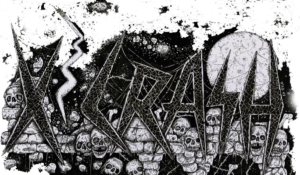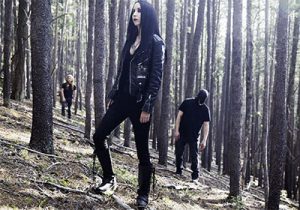 T.O.M.B.
T.O.M.B.
Eine Grufttür mit Tiefgang
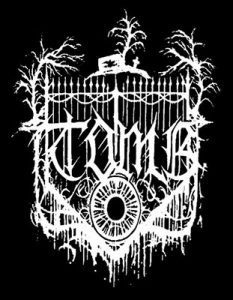 Da gibt es in Pennsylvania eine eingeschworene Einheit von Krachmachern, die nicht müde wird, irgendwo anzuecken. Im Vordergrund soll nun die Musik stehen, oder aber auch Krach, wie wir ohne vorgehaltene Hand sagen dürfen. Auf jeden Fall gehören sie zum Lärmigsten Zeug auf diesem Planeten, darüber muss nicht diskutiert werden. Für unsere Fragen stand uns Gitarristin Samantha Viola zur Verfügung, die noch bei den Dreadlords zockt, sich für unsere Fragen Zeit nahm und die Präsenz von Szenegrößen wie Mayhem und Watain erklärte …
Da gibt es in Pennsylvania eine eingeschworene Einheit von Krachmachern, die nicht müde wird, irgendwo anzuecken. Im Vordergrund soll nun die Musik stehen, oder aber auch Krach, wie wir ohne vorgehaltene Hand sagen dürfen. Auf jeden Fall gehören sie zum Lärmigsten Zeug auf diesem Planeten, darüber muss nicht diskutiert werden. Für unsere Fragen stand uns Gitarristin Samantha Viola zur Verfügung, die noch bei den Dreadlords zockt, sich für unsere Fragen Zeit nahm und die Präsenz von Szenegrößen wie Mayhem und Watain erklärte …
Joxe: Hallo Samantha! In der Vergangenheit kamen wir bereits einmal für ein Interview zusammen, das war nach dem Release des „Death Angel“ Albums der Dreadlords. Diesmal lass uns über T.O.M.B. sprechen. Vielleicht stellst du dich und die Mitglieder von T.O.M.B. den Lesern von X-CRASH einmal vor…
Samantha: Dreadlords und T.O.M.B. bestehen aus exakt den selben Mitgliedern. ‚No One‘ on Vocals und Percussion, B. Zimimay für Keyboards und Krach und mir selbst an der Gitarre. Wenn es um Musik geht, arbeiten wir so gut miteinander und können die Songs von einander so gut aufnehmen, dass wir zusammen einfach verschiedene Arten von Musik machen.
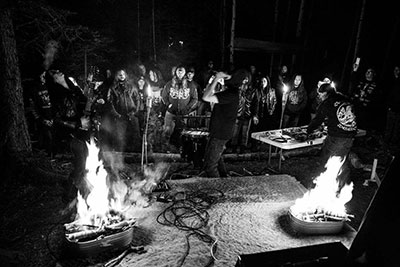 Joxe: Kannst du uns etwas darüber sagen, wie ihr den Namen der Band gefunden habt, wer mit der Idee von ‚Total Occultic Mechanical Blasphemy‘ kam?
Joxe: Kannst du uns etwas darüber sagen, wie ihr den Namen der Band gefunden habt, wer mit der Idee von ‚Total Occultic Mechanical Blasphemy‘ kam?
Samantha: Der Name ist aus dem Original-Konzept des Projektes: anstatt Studioaufnahmen öffentlich geleitete, den Tod darstellende Aufnahmen. Friedhöfe waren die erste naheliegende Wahl, und anstelle von Drums Grufttüren verwendet, wurde die Basis geschaffen, welche Art Songs geschrieben wurden. Dabei wurde das Projekt eine totale Präsentation des Todes. Beim Schreiben der Grufttüren-Songs war nichts eingeübt oder geplant, sie wurden durch das Gefühl in dem Moment in dem Raum eingespielt. Es ist ein starkes Element vorhanden, den Einfluss und die Energie der Umgebung zu kanalisieren. Das fügt ein sehr okkultes und ritualistisches Element der Musik zu. Die ersten Aufnahmen hatten keine Gitarre oder Keyboards; es war mehr eine Manipulation der Sounds der öffentlichen Aufnahmen durch mechanische Geräte, Rekordereffekte, Pedale, etc. Um in diesen Locations zu der Zeit unter Berücksichtigung eines totalen Antirespektes aller religiösen Glaubensrichtungen einen solchen Sound anzustreben, stellt den heiligen Ort auf eine harte Probe. Es war eine Störung der Dinge, die bei einem letzten Ruheort heilig gehalten werden, je nach Blickwinkel. Es war eine nie durchgeführte Form der Blasphemie, die total okkulte mechanische Blasphemy.
Joxe: Bitte erkläre doch mal deinen Weg zur Gitarre. Wie alt warst du da und hast du jemals Unterricht genommen?
Samantha: Ich hab erstmal Piano gespielt, bevor ich zur Gitarre kam. Ich musste mit dem Pianospielen mit drei Jahren anfangen und entschied mich mit zwölf Jahren für die Gitarre. Ich habe ungefähr drei Jahre Unterricht gehabt, aber ehrlich gesagt habe ich mich, nachdem ich den Unterricht stoppte, nicht mehr sonderlich bemüht, bis ich bei T.O.M.B. einstieg und noch einmal anfing:
Joxe: Wie bist du in die Band gelangt?
Samantha: Ich wurde der Band von einem unserer Kollektivmitglieder vorgestellt, Joseph Curwen. Wir kannten uns von einigen Tätigkeiten außerhalb des Projektes, und, wie die anderen mir sagten, fand er meine Auffassung und persönlichen magischen Praktiken ziemlich stark.
Joxe: Du spielst eine Gibson SG. Gibt es einen besonderen Grund, sie gewählt zu haben, die ja beispielsweise auch von Tony Iommi und Dave Chandler benutzt wird?
Samantha: Ich spiele eigentlich eine Les Paul. Ich lernte Das Gitarrenspielen auf der selben Bauform, meiner alten Epiphone, also ist es eigentlich so wie immer. Ich bevorzuge auch den Look, der mit anderen Formen vergleichbar ist.
Joxe: Hast du einen Part, den du besonders gerne spielst?
Samantha: Meine Gitarrenparts bei T.O.M.B. sind ziemlich simpel gehalten, um den allgemeinen ritualistischen Vibe beizubehalten und nicht von den Hauptkomponenten der Musik abzulenken. Mein Lieblingsriff von allen ist das in „Oblivion Dawn“. Es ist den ganzen Song lang immer dasselbe, aber sehr effektiv und ich verliere mich immer in seinem Feeling.
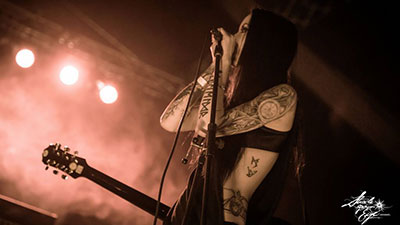 Joxe: Euer aktuelles Album „Fury Nocturnus“ wurde 2016 veröffentlicht. Es ist sehr roh und dunkel mit einem sehr dunklen Artwork. Bitte erzähl uns etwas darüber. Wer war der Künstler?
Joxe: Euer aktuelles Album „Fury Nocturnus“ wurde 2016 veröffentlicht. Es ist sehr roh und dunkel mit einem sehr dunklen Artwork. Bitte erzähl uns etwas darüber. Wer war der Künstler?
Samantha: Erik Danielsson von Watain hat das ganze Albumartwork designt, das hauptsächlich auf meinen Fotografien basiert. Das Cover ist seine künstlerische Umsetzung meines Fotos von der Grufttür, wo das Projekt anfangs startete. Die meisten Fotos sind von Orten, an denen wir aufnahmen oder die für uns zusammen wichtig sind.
Joxe: Was war der Einfluss von Hellhammer von Mayhem auf dem Album und was bedeutet dir sein Input?
Samantha: Es ist definitiv eine Ehre mit einem der kultigsten Drummer zu arbeiten und der noch von einer Band kommt, die ein ziemlicher Einfluss für T.O.M.B. ist. Er fügte etwas bei, für das niemand von uns das Vermögen gehabt hätte, uns den gewaltigen Sound mit Wucht zu geben, den wir wollten.
Joxe: Probt ihr mit T.O.M.B. in demselben Keller eines Beerdigungsinstitutes wie mit den Dreadlords?
Samantha: Nach den jüngsten Dreadlords Recordings ist nun No Ones Heimstudio unser Proberaum. Es ist eine zu einem Heim und Studio umgewandelte Kirche im Wald einer Stadt, die Upper Black Eddy genannt wird und in Pennsylvania liegt. Unser Equipment lagert dort, und wir haben eine Menge davon, also ist es einfacher, das dort zu tun.
Joxe: Was war euer weitester Gig? Die meisten waren bestimmt bei euch in der Gegend?
Samantha: Unser weitester Gig war 2016 beim ‚Kings Of Black Metal‘ in Alsfeld, Deutschland, aber das war unser einziger Überseegig bis jetzt. Wir planen auf jeden Fall, dorthin zurück zu kehren und würden vielleicht sogar eine Tour machen.
Joxe: Ihr seid eine der echt furchteinflößenden Bands, die definitiv nicht so tun als ob, sagt man auf teamrock.com. Wie denkst du darüber?
Samantha: Wir wissen die Beschreibung sehr zu schätzen, denn wir packen das echte Eigene in unsere Kreationen und versuchen nicht, für besondere Aufmerksamkeiten zu schwindeln.
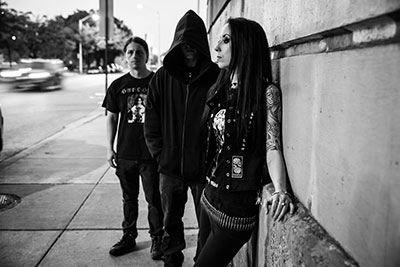 Joxe: Gegen Ende würde ich dich gerne fragen, wie die Dinge bei Dreadlords laufen. Wird es dort bald ein neues Album geben?
Joxe: Gegen Ende würde ich dich gerne fragen, wie die Dinge bei Dreadlords laufen. Wird es dort bald ein neues Album geben?
Samantha: Wir haben bis jetzt noch nicht wirklich über ein neues Album gesprochen. Irgendwie rotieren wir zwischen T.O.M.B. und Dreadlords, aber im Moment fokussieren wir uns auf T.O.M.B. und das nächste Album dieses Projektes. Wir planen definitiv mit dem Schreiben für Dreadlords zu beginnen, sobald die extreme Beschäftigungsphase mit T.O.M.B. abebbt.
Joxe: Zum Schluss möchten wir etwas über deine Lieblingsalben wissen. Welche Fünf würdest du aussuchen, wenn es morgen auf eine einsame Insel ginge? Ich nehme mal an, ein Album von Mayhem ist dabei …?
Samantha: Sisters Of Mercy – „Floodlands“, Mayhem – „Live In Leipzig“, Bathory – „Under The Sign Of The Black Mark“, Isengard – „Høstmørke“ und Mortiis – „Ånden Som Gjorde Opprør“.
Joxe: Samantha, Vielen Dank für die Antworten, die letzten Worte gehören dir!
Samantha: Thanks for the interview! Always a pleasure.
Joxe Schaefer
English Version:
Joxe: Hi Samantha! In the past we already came together for an interview, it was after releasing the „Death Angel“ album of Dreadlords. Now let’s talk about T.O.M.B.. Please introduce yourself and the members of T.O.M.B. to our readers.
Samantha: Dreadlords and T.O.M.B. actually consist of the same members: No One as vocals and percussion, B. Zimimay as keyboards and noise, and myself on guitar. We work so well together when it comes to music; we can write and pick up each other’s songs so quickly that we just make different kinds of music together.
Joxe: Can you tell us something about finding the name of the band, who came up with the idea of Total Occultic Mechanical Blasphemy?
Samantha: The name came out of the original concept of the project: instead of studio recording, conducting field recording at locations representing death. Cemeteries were the first obvious choice, and instead of drums, using crypt doors became the basis to which songs were written around. By doing this, the project would be a TOTAL representation of true death music. When writing the crypt door tracks, nothing was practiced or planned; it was done by feel of the moment taken within that location. So there is a strong element of channeling influence and energy from the environment. This added a very OCCULTIC and ritualistic element to the music. The first recordings had no guitar or keyboards; it was more a manipulation of sounds from field recording through mean of MECHANICAL devices: recorder effects, pedals, etc. By conducting such a style of music in these locations at the time was considered a total disrespect of any religious beliefs, deeming the location sacred or that of a place of holiness. It was a disruption of those things held sacred from a final resting place point of view. It was a form of BLASPHEMY never done before…..Creating Total Occultic Mechanical Blasphemy
Joxe: Please explain your way to the guitar. At which age was it and did you ever take lessons?
Samantha: I mainly played piano before picking up the guitar; I had started playing piano when I was 3. I decided to learn guitar when I was 12. I took lessons for about 3 years, but honestly didn’t bother with it much after I stopped lessons, until I joined T.O.M.B. and started up again.
Joxe: What was your way to get in the band?
Samantha: I was introduced to the group by one of our collective members, Joseph Curwen. We had spent time together at different functions outside of the project and, as the others told me, found my outlook on the occult and personal magic practices extremely powerful. As the others also told me, this was intriguing to the collective, so there was a meeting and very shortly after I was asked to be part of the project.
Joxe: You play a Gibson SG. Is there a special reason you have chosen that one, which is also used by Tony Iommy and Dave Chandler (St. Vitus) for example?
Samantha: I actually have a Les Paul. I learned how to play on a guitar with the same shape, my old Epiphone, so it’s just what I’m used to. I also just prefer the look of it compared to other shapes.
Joxe: Do you have a favourite guitar part you specially like to play?
Samantha: My guitar parts for T.O.M.B. are kept pretty simple to keep the overall ritualistic vibe and to not distract from the main components of the music. My favorite riff out of everything we have now is the one in Oblivion Dawn. It’s pretty much the same riff through the whole song, but it’s effective and I always get lost in the feeling of it.
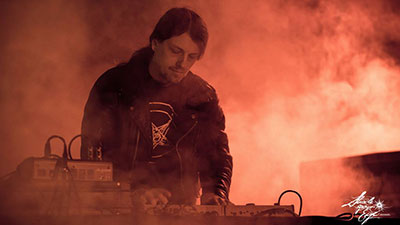 Joxe: Your current album „Fury Nocturnus“ was released in 2016. It is a very rough and dark one and it got a very dark cover artwork. Please tell us something about it. Who was the artist?
Joxe: Your current album „Fury Nocturnus“ was released in 2016. It is a very rough and dark one and it got a very dark cover artwork. Please tell us something about it. Who was the artist?
Samantha: Erik Danielsson of Watain designed all of the album art, which is mainly based on photographs I have taken. The cover is his artistic rendition of the photo I took of the crypt door where the project first started. Most of the photos are from places we have recorded at or various photos that are important to us as a collective.
Joxe: What was the influence of Hellhammer from Mayhem on the album, and what does his input mean to you?
Samantha: It’s definitely an honor to work with one of the most iconic drummers and from a band that is definitely an influence for T.O.M.B. He added an element that none of us had the ability to bring ourselves, giving us that huge sound and impact that we were looking for.
Joxe: Do you rehearse with T.O.M.B. in the same cellar of an institute for funerals as you do with Dreadlords?
Samantha: After the latest Dreadlords recording, our practice location is now No-One’s home studio. It is a church converted into a home and studio deep in the woods in a town called Upper Black Eddy, Pennsylvania. All of our equipment is stored there, and we have A LOT of equipment, so it’s much easier to convene there.
Joxe: What was your furtherest gig you played, most of them happened in the west, I guess?
Samantha: Our furthest show was when we performed at Kings of Black Metal in Alsfeld, Germany back in 2016, but that’s been our only overseas show so far. We definitely plan to return and would love to maybe do a tour.
Joxe: You are one of the most genuinely terrifying bands who definitely aren’t faking it, written in teamrock.com. what do you think about it?
Samantha: We all definitely appreciate that description, as we do put our genuine selves into what we create and aren’t trying to put on a fake act for special attention or to add shock value.
Joxe: At the end I would like to ask you, how the things are running in Dreadlords. Will there be a new album soon?
Samantha: After Reapers, we haven’t really thought much about another album just yet. We kind of rotate between T.O.M.B. and Dreadlords, so right now we’re focusing on T.O.M.B. and the project’s next album. We definitely plan to start writing for Dreadlords again once this busy streak for T.O.M.B. has quieted down.
Joxe: At least we would like to know something about your favourite albums. Which five would you pick, if your journey to the lonely island would start tomorrow? I guess a Mayhem album is one of them…?
Samantha: Sisters Of Mercy – „Floodlands“, Mayhem – „Live In Leipzig“, Bathory – „Under The Sign Of The Black Mark“, Isengard – „Høstmørke“, Mortiis – „Ånden Som Gjorde Opprør“.
Joxe: Samantha, thank you for answering … the final words are on you!
Samantha: Thanks for the interview! Always a pleasure.
Autor: Joxe Schaefer
